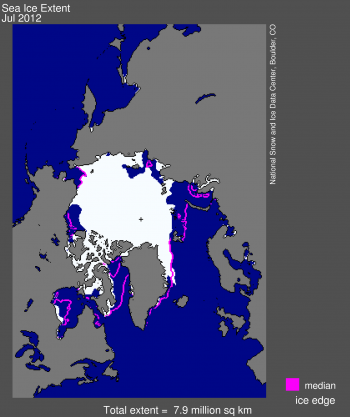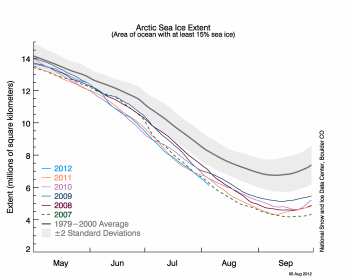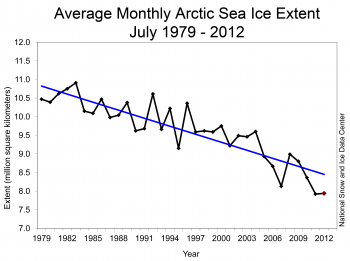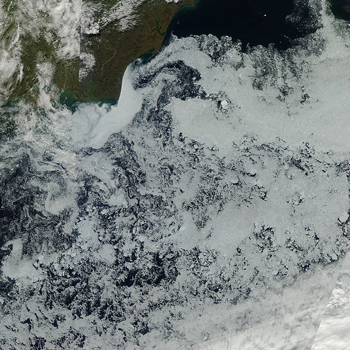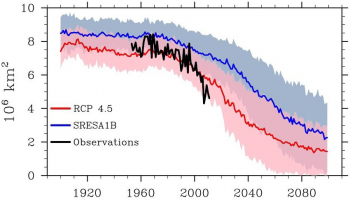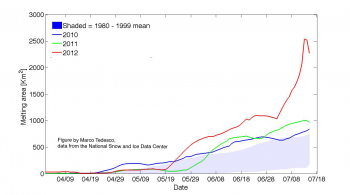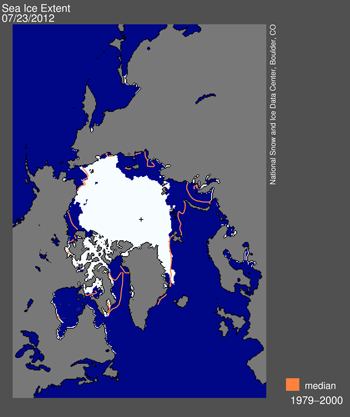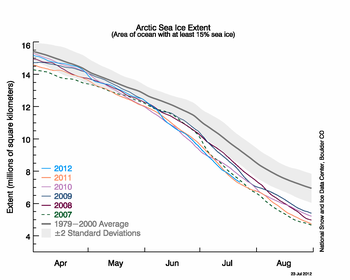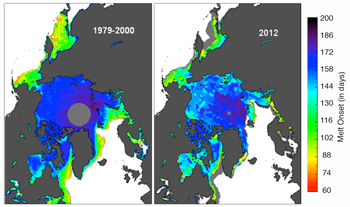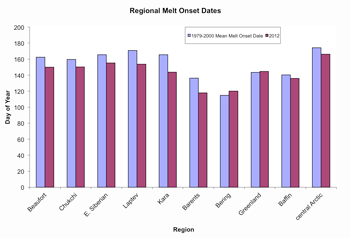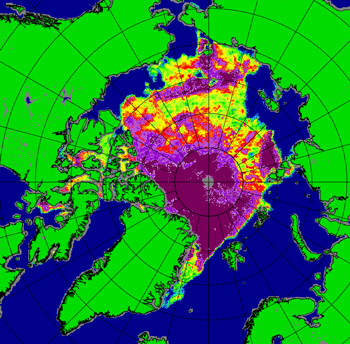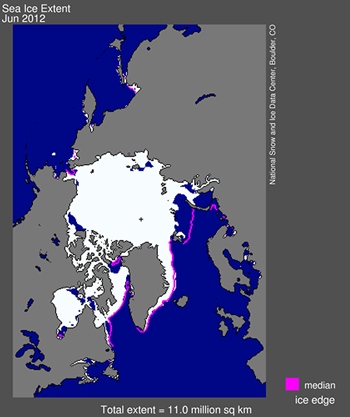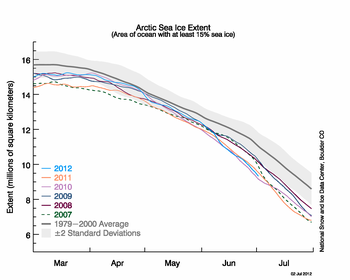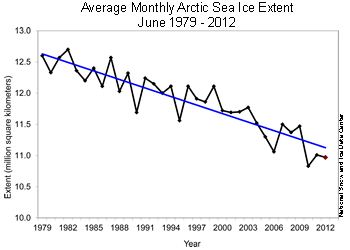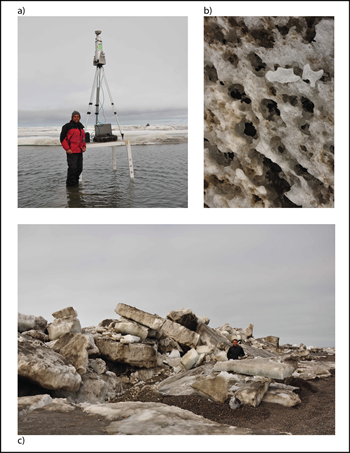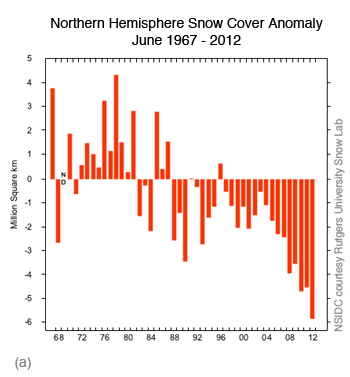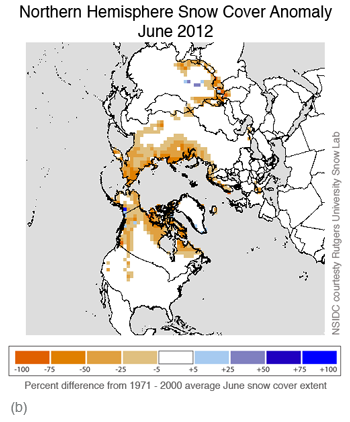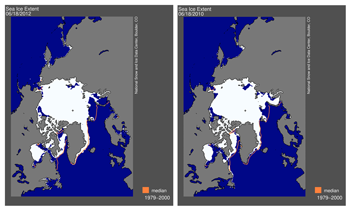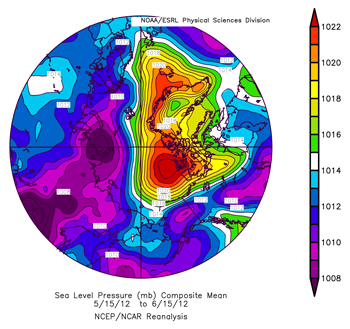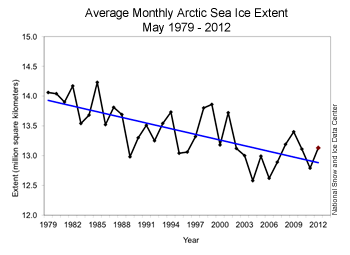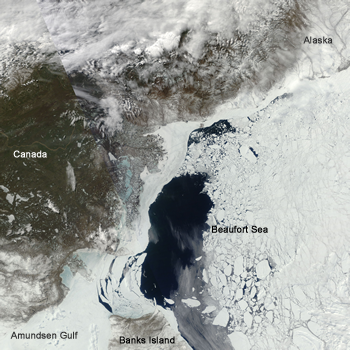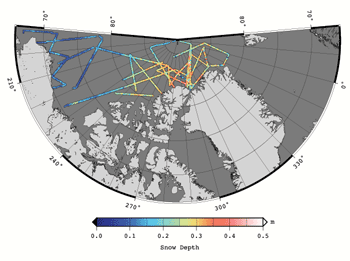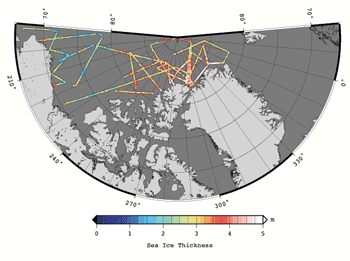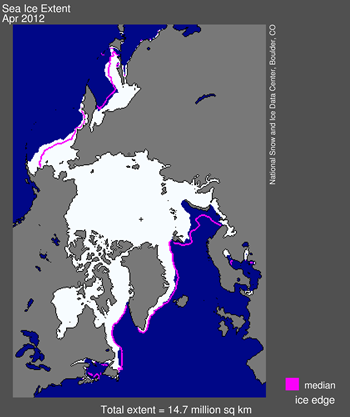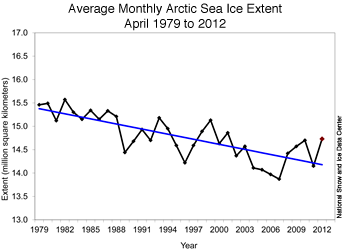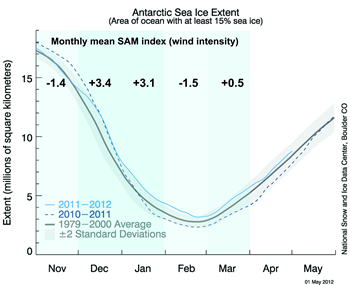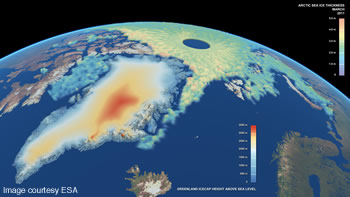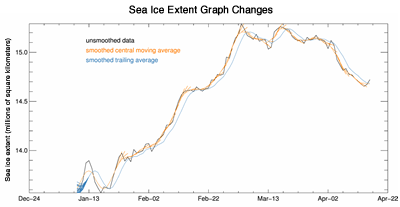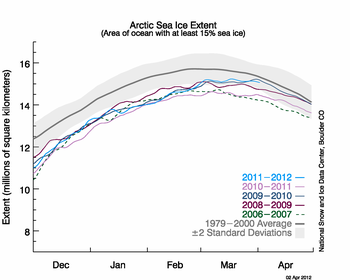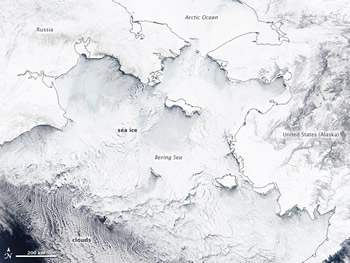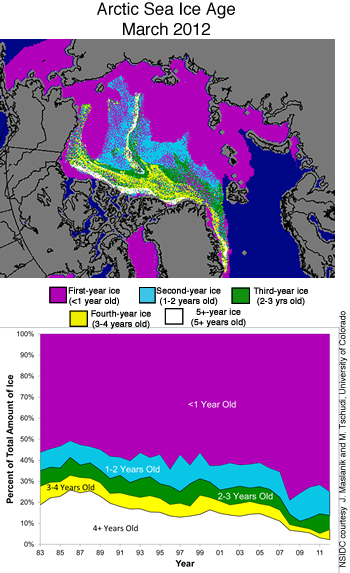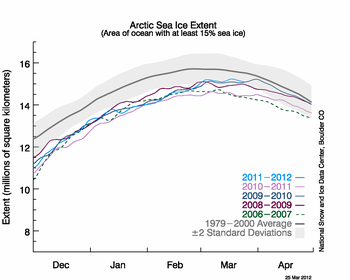Arctic sea ice extent during the first two weeks of August continued to track below 2007 record low daily ice extents. As of August 13, ice extent was already among the four lowest summer minimum extents in the satellite record, with about five weeks still remaining in the melt season. Sea ice extent dropped rapidly between August 4 and August 8. While this drop coincided with an intense storm over the central Arctic Ocean, it is unclear if the storm prompted the rapid ice loss. Overall, weather patterns in the Arctic Ocean through the summer of 2012 have been a mixed bag, with no consistent pattern.
Overview of conditions
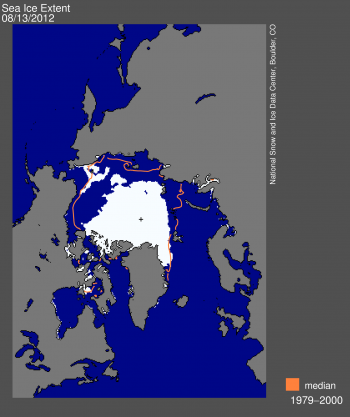
Figure 1. Arctic sea ice extent for August 13, 2012 was 5.09 million square kilometers (1.97 million square miles), 483,000 square kilometers (186,000 square miles) below the same day in 2007. The orange line shows the 1979 to 2000 median extent for that day. The black cross indicates the geographic North Pole. Sea Ice Index data. About the data
Credit: National Snow and Ice Data Center
High-resolution image
Arctic sea ice extent on August 13 was 5.09 million square kilometers (1.97 million square miles). This is 2.69 million square kilometers (1.04 million square miles) below the 1979 to 2000 average extent for the date, and is 483,000 square kilometers (186,000 square miles) below the previous record low for the date, which occurred in 2007. ( Note: The sea ice extent originally published on August 14, 2012 was the actual one-day value for August 13. We normally report the five-day trailing mean, so to be consistent we have updated the post with these numbers instead of the one-day value. See the Sea Ice Index Documentation for more information about the five-day trailing mean.) Low extent for the Arctic as a whole is driven by extensive open water on the Atlantic side of the Arctic, the Beaufort Sea, and—due to rapid ice loss over the past two weeks—the East Siberian Sea. Ice is near its normal (1979 to 2000) extent only off the northeastern Greenland coast. Ice near the coast in eastern Siberia continues to block sections of the Northern Sea Route. The western entrance to the Northwest Passage via McClure Strait remains blocked.
Conditions in context
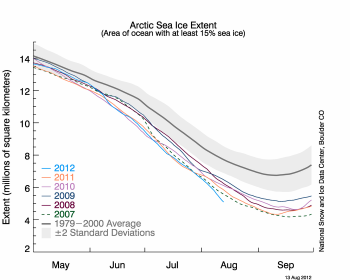
Figure 2. The graph above shows Arctic sea ice extent as of August 13, 2012, along with daily ice extent data for the previous five years. 2012 is shown in blue, 2011 in orange, 2010 in pink, 2009 in navy, 2008 in purple, and 2007 in green. The gray area around the average line shows the two standard deviation range of the data. Sea Ice Index data.
Credit: National Snow and Ice Data Center
High-resolution image
The average pace of ice loss since late June has been rapid at just over 100,000 square kilometers (38,000 square miles) per day. However, this pace nearly doubled for a few days in early August during a major Arctic cyclonic storm, discussed below. Unlike the summer of 2007 when a persistent pattern of high pressure was present over the central Arctic Ocean and a pattern of low pressure was over the northern Eurasian coast, the summer of 2012 has been characterized by variable conditions. Air tempertures at the 925 hPa level (about 3000 feet above the ocean surface) of 1 to 3 degrees Celsius (1.8 to 5.4 degrees Fahrenheit) above the 1981 to 2012 average have been the rule from central Greenland, northern Canada, and Alaska northward into the central Arctic Ocean. Cooler than average conditions (1 to 2 degrees Celsius or 1.8 to 3.6 degrees Fahrenheit) were observed in a small region of eastern Siberia extending into the East Siberian Sea, helping explain the persistence of low concentration ice in this region through early August.
The Great Arctic Cyclone of 2012
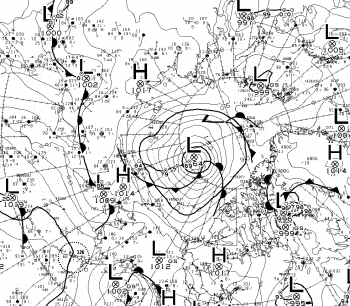
Figure 3. This subsection of the surface weather analysis from the Canadian Meteorological Centre for August 6, 2012 (at 0600 Greenwich Mean Time) shows a very strong cyclone over the central Arctic Ocean north of Alaska. The isobars (lines of equal pressure) are very tightly packed around the low pressure system, indicating strong winds. Greenland is on the right side of the figure while Canada is at the bottom.
Credit: Canadian Meteorological Centre
High-resolution image
A low pressure system entered the Arctic Ocean from the eastern Siberian coast on August 4 and then strengthened rapidly over the central Arctic Ocean. On August 6 the central pressure of the cyclone reached 964 hPa, an extremely low value for this region. It persisted over the central Arctic Ocean over the next several days, and slowly dissipated. The storm initially brought warm and very windy conditions to the Chukchi and East Siberian seas (August 5), but low temperatures prevailed later.
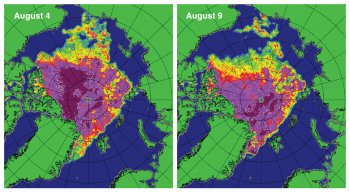
Figure 4. These maps of sea ice concentration from the Special Sensor Microwave Imager/Sounder (SSMIS) passive microwave sensor highlight the very rapid loss of ice in the western Arctic (northwest of Alaska) during the strong Arctic storm. Magenta and purple colors indicate ice concentration near 100%; yellow, green, and pale blue indicate 60% to 20% ice concentration.
Credit: National Snow and Ice Data Center courtesy IUP Bremen
High-resolution image
Low pressure systems over the Arctic Ocean tend to cause the ice to diverge or spread out and cover a larger area. These storms often bring cool conditions and even snowfall. In contrast, high pressure systems over the Arctic cause the sea ice to converge. Summers dominated by low pressure systems over the central Arctic Ocean tend to end up with greater ice extent than summers dominated by high pressure systems.
However, the effects of an individual strong storm, like that observed in early August, can be complex. While much of the region influenced by the August cyclone experienced a sudden drop in temperature, areas influenced by winds from the south experienced a rise in temperature. Coincident with the storm, a large area of low concentration ice in the East Siberian Sea (concentrations typically below 50%) rapidly melted out. On three consecutive days (August 7, 8, and 9), sea ice extent dropped by nearly 200,000 square kilometers (77,220 square miles). This could be due to mechanical break up of the ice and increased melting by strong winds and wave action during the storm. However, it may be simply a coincidence of timing, given that the low concentration ice in the region was already poised to rapidly melt out.
Further Reading
Long, Z. and W. Perrie. 2012. Air-sea interactions during an Arctic storm. Journal of Geophysical Research, 117, D15103, doi:10.1029/2011JD016985.
Screen, J. A., I. Simmonds, and K. Keay. 2011. Dramatic interannual changes of perennial Arctic sea ice linked to abnormal summer storm activity. Journal of Geophysical Research, 116, D15105, doi:10.1029/2011JD015847.
Serreze, M. C. and A. P. Barrett. 2008. The summer cyclone maximum over the central Arctic Ocean. Journal of Climate, 21, doi:10.1175/2007JCLI1810.1.
